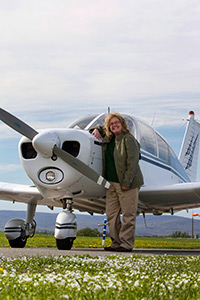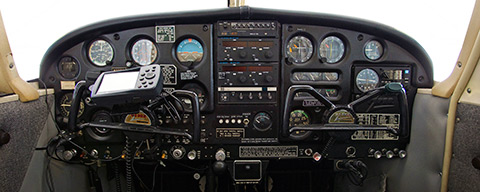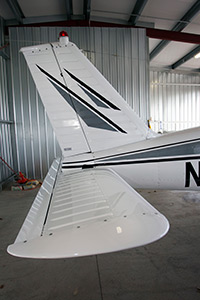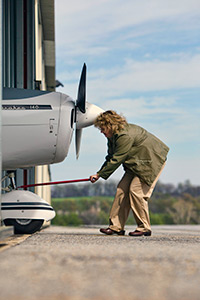 You know those “Win Me” airplane raffles that groups around the country hold from time to time? The ones where they sell only 2,500 tickets to assure you a better chance of winning? I’ve bought a couple of those tickets.
You know those “Win Me” airplane raffles that groups around the country hold from time to time? The ones where they sell only 2,500 tickets to assure you a better chance of winning? I’ve bought a couple of those tickets.
You know the airplane that EAA raffles off at AirVenture each year? The one with the announcer who hawks the tickets over a loudspeaker? I’ve bought more than a couple of those tickets. I’m not eligible to win any AOPA sweepstakes airplane, although I’ve coveted each one.
Wishing and hoping, however, only get you so far. A better financial situation combined with a soft used-aircraft market took ownership from the realm of fantasy to a reality for me. I took the plunge and bought an airplane last year, and I’d like to offer some lessons learned from that experience. Somebody on the Internet once said, “You only know what you know,” and that’s true for everyone, even those of us who work at the world’s largest general aviation advocacy organization.

What’s your mission?
Look at the type of flying you do now, and consider the type of flying you hope to do once you acquire your new ride. Perhaps you have always had your heart set on a roomy traveling machine such as a Cessna 182, or a speedier steed such as a Cirrus SR22. You might want to bring the entire family along, and so more seats might be needed and a Piper Cherokee Six seems like a good match.
It’s fine to plan for the type of flying you want to do, but it’s equally as important to be realistic about the type of flying you have been doing and will do in the future. For me, that meant taking a hard look at my flying over the 10 years I’ve had a pilot certificate.
Like many people, I dreamed of taking my family (husband and two kids-now-teenagers) to the beach, to the mountains, to Florida—heck, to California. Guess how many trips by GA the four of us have taken together? Two. A hundred-dollar hamburger the week I earned my certificate, and a hundred-dollar brunch at Sky Bryce Resort in Basye, Virginia, a few years later.
Mainly that’s because in 2001, the kids and the husband and I were small enough to fit into a Socata Tampico TB9. By 2005, the Tampico no longer held all of us and full fuel, so I got checked out in a Cessna 182. Problem solved! Except I couldn’t afford to stay current in the 182. A few years later I did take the kids to the beach and to Sandusky, Ohio, for a wonderful amusement-park visit. For that trip I got checked out in a Socata Trinidad, and it, too, was an expensive date that I couldn’t really afford.
These past few years, my flying has been for my work here at AOPA and to take my daughter to visit colleges. My son will be ready for those trips next year. And I plan to do some animal rescue flights plus the usual breakfast and lunch runs and the occasional overnighter with one passenger. For those, I don’t need an if-I-win-the-lottery type of airplane. I set a budget of $30,000 to include a reserve for maintenance and upgrades, and eventually (after regretfully rejecting the Ercoupe) decided that a Piper Cherokee 140 would best fit my needs. Other things that factored in the selection of this particular make and model: lots of aircraft available on the used market; plenty of parts still available; and more than enough capacity for two people, luggage, and full fuel.
How far are you willing to go?
Some people have no problem with traveling great distances to seek out the perfect airplane—but with a limited travel budget and a busy work schedule, that didn’t appeal to me. I limited my search to Maryland, Pennsylvania, and Virginia so that I could readily fly myself to look at airplanes. The search functions on Trade-a-Plane and Barnstormers.com proved invaluable for this type of shopping.

A few months’ perusing produced three viable candidates amid a lot of overpriced offerings. One of them was practically delivered to my doorstep: When I called the owner to inquire, he told me it would be at Frederick Municipal Airport for some planned maintenance. I went to investigate, and sure enough, it was sitting on the ramp. I got to give it a good once-over and discovered that, although it was equipped to my specifications and within my price range, it had a 40-year-old paint job that had developed a flaked, reptilian pattern along the tail. The owner wasn’t interested in dropping the price any further, and I wasn’t interested in spending another $10,000 to give it a facelift.
On to candidate number two, a Cherokee 140 owned by a partnership. Two of the three owners were no longer interested in flying, and the airplane was priced to sell. But it wasn’t equipped with the 160-horsepower upgrade that I wanted and its panel was strictly VFR. Those are two upgrades I didn’t want to take on. And, although I felt badly for the remaining owner, I didn’t want to buy it out of pity.
Once you have found her, never let her go?
When you’ve found a keeper, how far will you go to make the deal happen? What’s a deal-breaker? It’s best to figure this out before you make an offer.
I contemplated walking away after making an offer on that third viable candidate—a 1964 Cherokee 140 based in Pennsylvania. The owner, a retired gentleman, had taken beautiful care of 7301J, and sincerely hated to let her go. The price of fuel coupled with the fact that he was flying her less and less brought him to the reluctant conclusion that he should sell.
He accepted my offer. But when I mentioned taking the airplane to a maintenance shop in Maryland for a prepurchase inspection, he hesitated. And then he called me and said, in essence, no dice. He’d heard stories from his airport friends about airplanes being “held hostage” by nefarious shops. If I wanted to use his mechanic, fine. If I wanted to bring a mechanic to the field to do an inspection there, fine. But he wasn’t letting the airplane leave.
An objective overview was important to me. Lots of people would have walked away, but if there’s room for negotiation in the asking price based on developing issues—as there certainly would be if a prepurchase inspection turned up a squawk—then you still have options. So I hung in. Finding an A&P mechanic willing to travel wasn’t easy, but when I put the call out to pilot friends, referrals emerged, and one of them indeed drove to Pennsylvania and completed the prepurchase inspection—and he did a good, thorough job.
Tap the experts
 At each step in the purchase process, I didn’t hesitate to seek advice and get help from people who are very well-versed in airplanes—namely, the other folks who work at AOPA. The first time I went to scope out 7301J, I brought along a colleague from AOPA’s Pilot Information Center. I knew I could spot something as obvious as hail damage or corrosion on the outside of the airplane (there was none), but he knew how to comb the logbooks for things such as previous damage history (there was none) and compliance with airworthiness directives (all except a 2010 AD ordering inspection of the control-wheel shafts had been completed, and the seller had meticulous documentation, to boot).
At each step in the purchase process, I didn’t hesitate to seek advice and get help from people who are very well-versed in airplanes—namely, the other folks who work at AOPA. The first time I went to scope out 7301J, I brought along a colleague from AOPA’s Pilot Information Center. I knew I could spot something as obvious as hail damage or corrosion on the outside of the airplane (there was none), but he knew how to comb the logbooks for things such as previous damage history (there was none) and compliance with airworthiness directives (all except a 2010 AD ordering inspection of the control-wheel shafts had been completed, and the seller had meticulous documentation, to boot).
Another PIC colleague reviewed the airplane’s age, equipment, and engine time, and double-checked the Vref numbers. After the seller and I had agreed upon the purchase price, I set up an escrow account and title search through AIC Title Services. This not only helped me to keep track of needed documents, but also made me adhere to a deadline of sorts, which was handy because we were heading into the Christmas season at the close of the sale.
As this article was being written, about four months into ownership, it still seems a little incredible that I have an airplane waiting just for me, to fly any time I want. My bank account would argue otherwise; I’ve already dropped some money for a Garmin 496 and am shopping for an STC’d set of shoulder harnesses. But reality is beginning to set in as I plan treks to the Outer Banks in North Carolina and to Oshkosh, Wisconsin, for EAA AirVenture—trips I couldn’t have made in rental aircraft. Whenever I head to the airport and see Miss J waiting for our next outing, I know that the move from renter to owner was right for me. I wish the same for you.
Email the author at [email protected].
Buying an airplane? Put us to work for you
The people, products, and services that helped me purchase my airplane are here to help you, too. —JWT

- Start with the Aircraft Ownership Information tab at AOPA Online. Here you'll find subject reports on buying and selling an airplane; an extensive report on partnership and co-ownership options, and sample purchase documents—as well as information on maintenance, starting a flying club, and much more.
- AOPA's Pilot Information Center is staffed with aviation experts who are available to take your questions on any aspect of ownership. Call 800-USA-AOPA weekdays between 8:30 a.m. and 6 p.m. Eastern, or email [email protected] .
- Peruse aircraft fact sheets on nearly 100 makes and models.
- Ready to deal? Use the Vref online tool as a starting point to determine the general retail value of the airplane you have in mind.
- AOPA's Aircraft Financing Program offers online application through Bank of America.
- The Legal Services Plan can be used to review your sales agreement.
- The AOPA Insurance Agency offers member discounts, online quotes, and a knowledgeable staff that will work to find the coverage that fits your needs.
- AIC Title Service offers escrow and title services, title insurance, and lien clearance, and can even act as a qualified intermediary for a tax-free exchange.



